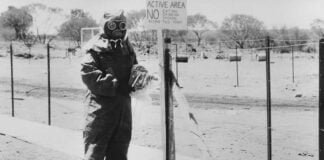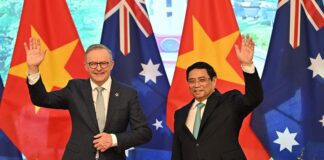JANUARY 2008 marked the 40th anniversary of the Vietnamese “Tet Offensive” against US and South Vietnamese armies. On the 31st of January 1968 the National Liberation Front (NLF) entered 36 major towns and cities in South Vietnam. Since the beginning of the war three years earlier the US had been backing the southern government with troops, armaments and aid. The vast majority of this war was fought out in the countryside. But in the second half of 1967 the NLF had begun planning an incursion into the south with the aim of either defeating the US rapidly, or forcing the US into a gradual withdrawal.
Despite the fact that the NLF captured numerous towns and held pockets of resistance within Saigon for days-capturing a part of the US Embassy for over a day-the offensive was a military loss for the NLF.. But by demonstrating that the US was not invincible, Tet was a substantial political victory against US imperialism.
The timing of Tet was perfect. It intersected with a growing anti-war movement in the US, a troubled US economy and other challenges to US political and economic dominance across the world. Prior to American direct involvement in Vietnam in 1965 US foreign policy was characterised by a supreme belief in its strength to maintain its hegemony.
In Iran in 1953, it had successfully backed a coup against an elected government which planned to nationalise US and British oil companies. In the Congo, Patrice Lumumba came to power at the head of an independence movement, but when he proved too unfriendly to US geopolitical interests, they had him assassinated in 1961. In Guatemala an elected reformist, President Arbenz, threatened to nationalise the American-owned United Fruit Company. The US organised a coup to remove him in 1954.
However, the Cold War, the end of the post-war economic boom, the growing strength of China and the spread of national liberation struggles through Asia was beginning to erode the favourable political situation the US found itself in after World War II. The year after the Chinese Revolution of 1949 the US began a war against the North Korean communist regime. The conflict ended three years later in a stalemate between North and South Korea after China entered to defend North Korea. America had lost half of Korea to the “communist bloc” and it began looking to prevent the spread of Russia and China’s influence.
During the Korean War the US had begun backing the French colonial regime in Vietnam in an attempt to stifle “communist” expansion. When the French pulled out the US believed it could send in ground troops to crush the peasant liberation forces.
Since the end of WW2 they had been doing as they pleased and the worst that occurred was a stalemate in Korea. However by 1968 the US had over half a million troops in Vietnam, had suffered tens of thousands of dead US soldiers, and was beginning to feel the economic effects of fighting a prolonged war on the other side of the world. Furthermore, during the closing months of 1967 President Johnson had been telling the public that the US were winning a war for democracy in Vietnam, that the worst was just about over, and that the war would soon end in US victory.
As the NLF forces attacked US strongholds throughout the south the media beamed images back to the US and across the world. These images of poorly armed peasant women and men fighting the most powerful military machine in the world contradicted what the Johnson administration had been telling the American public. Tet quite abruptly highlighted three things: The war was not a war for democracy, but rather, a war against a popular independence movement; The US and their South Vietnamese supporters were nowhere in sight of winning the war; Both poor Vietnamese and poor American soldiers were dying for a fight that was in the interests of neither.
In the US Tet fed into the anti-war movement and fuelled the growing discontent with the war. Around the world it intersected with and inspired numerous movements against both US and Soviet hegemony. With the beginning of the war in 1965 numerous college campuses had become sites for opposition to the war. Both students and lecturers alike had supported Lyndon Johnson in his Presidential campaign on the basis that he was purportedly pro-peace. Even the soon to be radical group Students for a Democratic Society (SDS) had supported Johnson’s reformist pledge of building the Great Society.
Within the first few months of the war SDS called a demonstration in New York and 25,000 people turned up. By October 1965 there were 100,000 people demonstrating around the country. During 1967 the anti-war movement began to make links with the Civil Rights movement. Dr Martin Luther King openly voiced his opposition to the war and opposed the disproportionate number of black men being sent to die in Vietnam.
Opposition to the war was strengthening and began to spread into numerous sections of American society. By April 1967 300,000 were marching in New York City.
Around the world 1968 saw waves of protests, strikes and riots. In France, in May, student and worker strikes involving millions took the possibility of revolution into the heart of Europe. In Mexico student demonstrations before the Mexican Olympics were put down by the military, with over a hundred deaths.
While Tet was not a military defeat for the US, it was a turning point in the war and showed that the mightiest military power on Earth could be defeated. It inspired and encouraged national liberation struggles everywhere-from the Middle East to Nicaragua and El Salvador in Latin America.
Back in the US the growing movement had led to the end of Johnson and the election of Republican Richard Nixon who had campaigned that he had a plan to end the war. The plan turned out to be carpet bombing of Cambodia and North Vietnam. The repression at home also grew. In mid-1969, during a rally against the escalation of the war, four students were shot dead by the National Guard at Kent State University. In one week 150,000 responded by marching in Washington.
At the end of 1969 the anti-war movement staged the largest demonstration in American history-500,000 people marched in Washington.
Tet was the beginning of the end for the US-finally being forced to withdraw from Vietnam in 1975. For years after the American ruling class struggled to overcome the legacy of its defeat, the “Vietnam syndrome”-a general anti-war sentiment and an unwillingness to support US imperialist adventures overseas.
Successive Republican and Democrat administrations launched military ventures to overcome domestic opposition and demonstrate that the US retained the ability to intervene around the world. In 1983 the US invaded Grenada and then Panama in 1989. During the 80s, Ronald Reagan backed the right-wing Contras against the Sandanista government in Nicaragua. George Bush the First the launched a much bigger scale intervention against Iraq in 1991. Under Bill Clinton military operations were launched one after another-in Somalia, in Bosnia, against an alleged guerilla camp in Afghanistan, a pharmaceutical factory in Sudan, then all-out war against Serbia in 1999.
No doubt, George W. Bush hoped that the “Vietnam syndrome” was banished forever, but the occupation of Iraq has seen a new anti-war movement grow in the United States. Vietnam Veterans Against the War, started in 1967, has provided support for Iraq Veterans Against the War.
The economic consequences of the Iraq war may also be coming home to roost. In Vietnam, the end of the boom meant that the US could not afford the cost of the land war in Vietnam. The US could not meet the challenge of its global economic competitors and domestic spending was savaged to pay for the war. Ruling class opinion shifted against the war.
Now while President Bush denies that the war in Iraq has hurt the US economy, Jospeh Stiglitz has published a new book, The Three Trillion Dollar War: The True Cost of the Iraq Conflict that puts a conservative estimate of the war’s cost at $3 trillion so far. The amount spent on the war contrasts dramatically with the spending on re-housing the victims of Hurricane Katrina or the thousands losing their homes to the sub-prime crisis.
The cost of the war is also stirring anti-war sentiment amongst the organised US working class. Unlike the Vietnam War, when much of the working class supported the US war effort, the recent tour of Kathy Black from US Labour Against the War showed that sections of the labour movement is now actively involved in bringing a halt to the war in Iraq. Longshormen (the equivalent of our wharfies) on the US West Coast are holding a strike on 1 May in opposition to the war.
While there has been no decisive Tet event as yet in Iraq, the on-going resistance, most recently in Basra, shows that the US is still not the invincible military force that the neo-cons launching the war pretended.
There is a vital lesson from the Vietnam experience-the need to build an organisation opposing the expansion of war, that is willing to mobilise against both domestic and international manifestations of the war-mongering. Building that movement is the best assistance we can give to those facing the brunt of US imperialism in the streets of Basra and Baghdad.
By David Robertson





